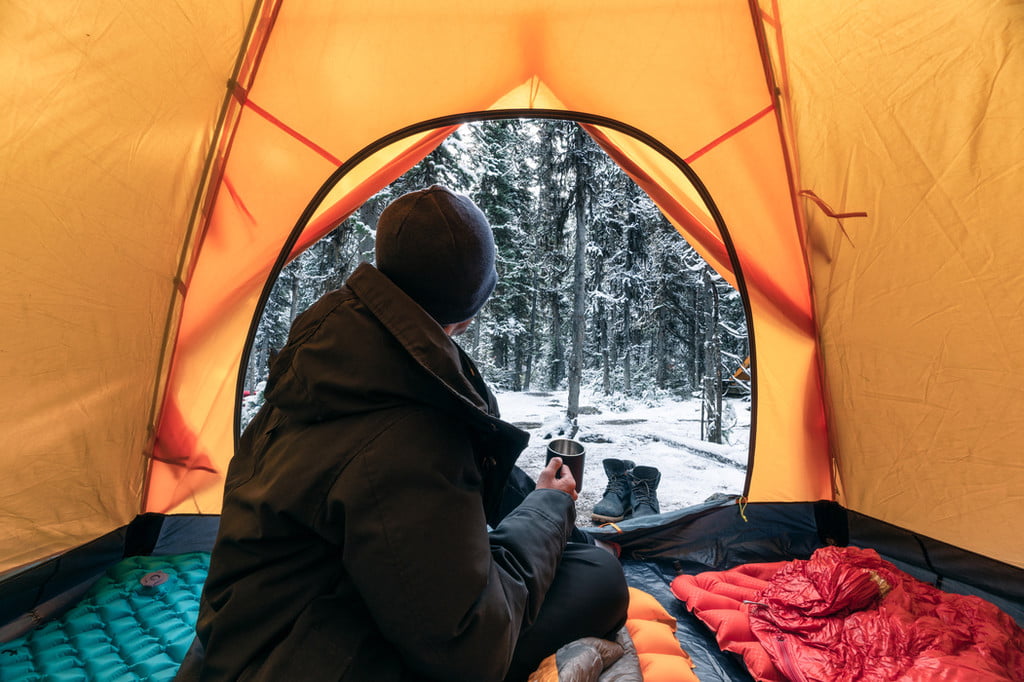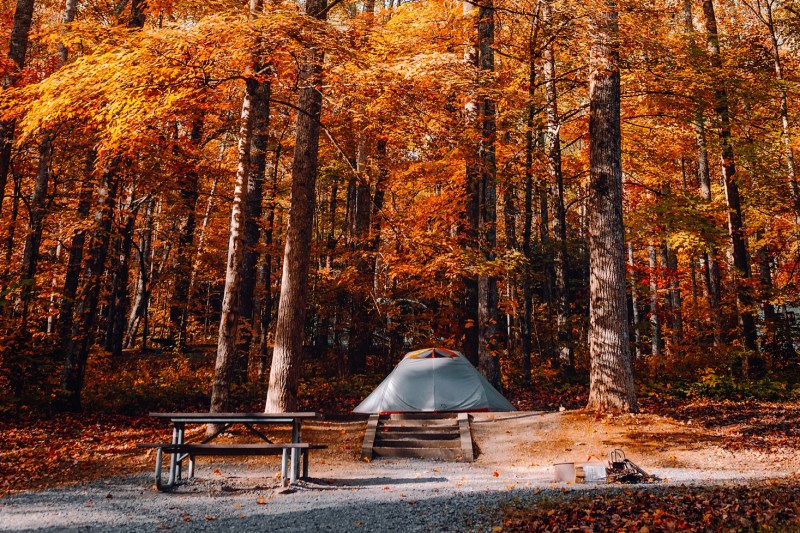If you’re a true adventurer at heart, you might dread the moment when you have to store your tent. The dropping temperatures can be enough of a deterrent for most people, but with the right gear and the right attitude, you can extend camping season into the fall or even winter months.
Why you should camp during the “off-season”

Camping during the so-called “off-season” can be even more rewarding than you might realize. Sure, it will be crisp, but there are plenty of tips out there to help you stay warm. Camping during the winter is particularly great because campsites will be less crowded. You’ll be able to experience the beauty of your favorite campgrounds when they’re transformed by frost, snow, or even fall foliage. Since it will be quieter, you might even spot more animals. Trails will be less congested, and they’ll be more beautiful than ever.
With the proper clothing layering system, you’ll be able to stay warm throughout the day. But what about at night? That’s where our top tips come in handy.
Top 9 tips for staying warm in your tent this fall or winter

1. Plan ahead
Just like with any other outdoor adventure, get an idea of what you’re getting into on your cold-weather campout. Check the weather forecast, and pay particular attention to factors like overnight low temperatures, approaching storm systems that could bring rain or snow, and other potentially extreme conditions, like high winds. And then, tailor your adventure kit to handle anything coming your way.
You may need to pack warmer clothing layers to combat icy evening temperatures, to bring an additional ground cover to cope with damp conditions, or to carry extra guylines to help stabilize your tent in case of high winds and heavy rain or snow.
2. Get the right tent
Your camping sleep system is the foundation of a comfortable night under the stars. We’ll look at the temperature ratings of sleeping bags and sleeping pads shortly, but there’s more to it than that. Your sleep system should start with your shelter. Winter doesn’t mean you have to pack away the hammock, tarp, or bivvy, but in reality, most people choose to sleep in a tent year-round. If you’re a keen hammock or bivvy user, these tips will still work for you, though, so read on.
The reliability and versatility of a tent simply cannot be beaten. They work for everyone, from first-time campers to grizzled mountaineers. But tents vary. Remember that in cold weather, smaller tents retain your body heat more effectively than larger tents and your sleeping bag’s rating relies on it being used in an appropriate shelter. Try to keep your tent well ventilated too, or condensation from your breath can freeze on the inside and cool things down.
A three-season tent will be better suited to withstand the rough weather of fall and winter and if you’re going anywhere really extreme, a four-season tent is essential. You don’t want to be crawling from the wreckage of your tent in the early hours of the morning to repair a busted pole or re-tie a guy line.
3. Check your gear ratings
On a cold-weather adventure, bringing the right gear is essential — and can be the difference between a restful sleep, or a night spent shivering in your sleeping bag. In particular, check the temperature ratings for your sleeping pad and your sleeping bag to be sure that your gear can handle the most extreme cold camping conditions you’re likely to encounter on your campout.
Sleeping bags typically feature either a ‘comfort rating’ or a ‘lower limit rating’ to provide an indication of the temperature range the bag is designed to handle. To assess the cold weather capability of your sleeping pad, check the R-value: a measure of the pad’s ability resist to heat flow. A pad with a higher R-value provides better protection against heat loss triggered by sleeping on the cold ground, a process called conduction. Typically, sleeping pads with an R-value of 4 or higher are designed for cold-weather or rainy camping trips.
If in doubt, a compact sleeping bag liner made of merino wool, Thermolite, or fleece can provide an additional 15 to 25 degrees of warmth. In especially extreme temperatures, consider packing an ultralight backpacking quilt as well as your sleeping bag.
4. Pick a strategically situated campsite
In extreme weather, selecting a campsite that offers a little protection from the elements can lead to a more restful night of camping. If you’re worried about high winds, look for a spot where natural features like brushy bushes, trees, or boulders provide a little buffer from blustery gusts.
However, while trees can offer protection from the wind, in snowy conditions, try to avoid camping beneath a tree with branches that could dust your tent with snow during the night. And in the daylight, be sure to take full advantage of the sun’s warming potential. Gauge the direction of the sunrise, and if possible, position your tent so that the sun’s rays will hit your tent at first light and warm you up through the morning.
5. Pack an extra outfit for sleeping
At the end of the day, when you’re ready to crawl into your sleeping bag, make sure you have dry clothes for the night. In wet or snowy weather, this might mean you need to stash your sleepwear in a dry bag to be on the safe side. Choose fabrics that will keep you warm, while also wicking moisture away from your body to prevent sweating.
Opt for clothing made from merino wool or synthetic fabrics like polyester and polypropylene, which help regulate body temperature and moisture, and leave the cotton layers at home. And, don’t forget about your head and your feet, and be sure to pack a hat or a balaclava, along with a heavy-duty pair of socks for sleeping.
6. Warm up your sleeping bag with a hot water bottle
When you are ready to call it a night, fill an uninsulated stainless steel or heavy-duty plastic bottle with piping hot water and stick it in your sleeping bag. If using a plastic water bottle, just be sure it’s tough enough to handle scalding liquids and is free of BPA (bisphenol A), BPS (bisphenol S), and phthalates, particularly because these synthetic chemicals leach into the water more rapidly when exposed to high temperatures.
7. Bring a tarp for added protection from the elements
On a backpacking trip, hauling a bulky plastic tarp into the backcountry can be a real hassle. But, when you’re camping in extreme weather, a study plastic tarp can be a genuine bonus. Try hanging the tarp over your tent for added protection from frigid rain, strategically string your tarp behind your tent as a wind block, or lay it beneath your tent to provide an additional buffer against the damp ground.
8. Eat a hot meal
One of the easiest ways to warm up on a chilly night is to eat a hot meal. Since you burn more calories when it’s cold out, make sure that your meals are high-calorie foods. Simple meals are best, and any meal prep that you can do before you go will make the entire process easier. Not all camping stoves are suitable for below-freezing temperatures, so opt for a campfire or a winter-grade
9. Answer the call of nature
Late-night bathroom trips are always a pain — and they’re even more annoying on cold-weather camping trips. On an icy night, it’s tough to leave a cozy sleeping bag, and it’s tempting to ignore your bladder as long as possible. But your body burns up precious calories, warming the urine stored in your bladder. So in the end, it’s better to just go. Of course, in truly brutal conditions, you can also consider bringing a leak-proof pee bottle. Opt for a wide-mouth bottle or glass jar with a closable lid — and just be sure to clearly label your pee bottle, so there’s no possible chance of a mixup.
If you intend to make the most out of the camping “off-season,” we hope that these tips were useful!




